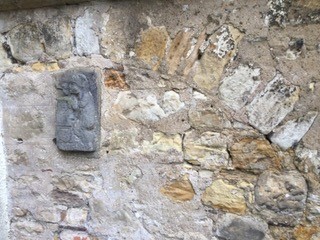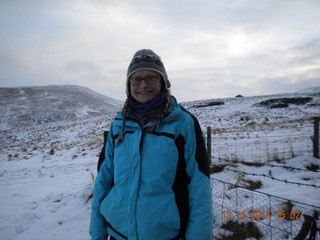Helen Boden

(i) Descriptive Sketches, or A Stone Boulangerie
Description:
- a (superceded?) staple for the writer of place-poetry
- a means of enabling a partially-sighted or unsighted person to experience an artwork
After Juliana Capes’s ‘Artist-Led Description and Walk’, on the Sunday afternoon of StAnza 2023 – a late highlight – I wanted to think a lot more about points of intersection between these two possible descriptions of the word description, as well as to ponder further questions raised:
What do we do when we describe?
How do we describe?
What wider function does it have?
Who do we describe for?
Juliana invited us, twenty StAnza attendees, to witness and accompany her ‘descriptive walk’.
An invitation, too, to glisk: to glance, to glimpse, to look slowly – and look collectively.
The route itself described a figure 6 from the front entrance of the Byre Theatre, sunwise back round to South Street.
The method: to demonstrate the communication of the unseen. By-product of method: description itself as creative process and performance.
(My method: to participate, absorb as much information as possible from both walk leader and environment, thinking specifically about its implications for poetry and potential for poetic analogy. And to resist taking a lot of photos – as a dyspraxic and ND person, this diminishes my presence in a situation, both for practical / proprioceptive reasons, and because it encourages me to think too much about how I’ll later use them to convey the experience.)
I know Juls as a freelance Education (recently rebranded as Learning & Engagement) colleague at National Galleries Scotland. Her specialism is leading tours for people with visual impairment; mine, ekphrastic writing. Her purpose in St Andrews is to apply a methodology of describing paintings and other artworks to the 3-D, 360-degree natural /built, still / moving, colourful environs of the Byre. It’s an enticing remix of the act of attention that poets of place are accustomed to paying.
She presented us with a template for description, a walking score that was itself an invitation, a line-poem. Paraphrasing:
- Look up, down, around, you take your time, notice where built horizon meets sky – what’s moving across it and how fast?
- Consider the effect of light, look at light-absorbing densities
- Start with a sketch, then fill out the detail
- Develop a of sequence of looking
What like is it?
Describing place in this way is a richly metaphoric, and therefore essentially poetic, process – you say what something is by saying what it is not, for someone who isn’t able to see it clearly or at all. Most compellingly for me, a sandstone wall was a ‘boulangerie of bricks’ or loaf of stone. A baker’s daughter who might have preferred to be a drystane dyker’s, this may already be my Metaphor of the Year.
What like is it? – A ghost of a tree clipped / a rusted pipe, dripped
More generally, maybe more conventionally, Juliana employs natural analogy to describe the manmade: in the close by the Byre, a ‘forest of dwellings’ linked by a concrete-tunnel ‘glade’; a building ‘the height of perhaps a silver birch.’
Our guide, who wasn’t very familiar with St Andrews, also asked ‘how do you describe a place you haven’t been to?’ For a group of poets, most of whom probably did know this location pretty well, thoughts may well have turned to something else poets do: defamiliarize, and make fresh, the familiar. Of course there is an implied challenge here to the normative requirement to have longstanding engagement with a place in order to have the authority to speak of / for it. So what perspective and value can the new & unfamiliar presence bring? Her suggestions also got me wondering about how I look at somewhere I haven’t actually been to at all, or I wasn’t (yet) at. I usually have a mental image of a new place I’m preparing to travel to, only partially informed by guidebook / brochure / internet pictures and maps; on arrival things are frequently a different way round, or different size to what I was expecting.
And how do you describe colour?
After an hour we’d physically travelled no more than a few yards from the Byre. We finished by considering the colours, and colour contrasts, of the street visible from near the entrance / exit to the theatre close – complementary conversations of doors and doorbells, dialogues between windows and facades (What would you call the colour of the frontage and awning of the gelateria opposite? Mint Ice Cream? Janetta Green? Crème de Menthe? Absinthe?)
Collect sml and lg permissions – to look at / into people’s environments. This one might well be up for discussion in a wider context of poetics, seeing and the gaze – please comment! – but for now an orange dishcloth dayglowed from a dull window-sill; fairy lights on the inside of an upper window cascaded into dialogue about the passing season with Winter Jasmine, trailing into flower over the courtyard wall. Wordsmiths who do not also have a regular painting, drawing or making practice gave themselves permission, and tools, to look as a visual artist does. I was full of potential haiku.
Collect sml and lg permissions – to adapt for own pedagogic practice. The ever-willing Edinburgh South Side Writers have been adapting to returning from Zoom to their converted-church community-centre base, by re-turning to it as stimulus for new writing. Before StAnza / winter: the ornamentation and clutter of the main, multi-activity hall (which if you’re a fringe attender interested in physical theatre, you may know as Southside Zoo). After StAnza / spring, and after writing description in relation to a still life handily left in the room by the art group: the façade, the skyline and streetlevel contexts in which the building is sited, the overwhelm of the city (my perspective: theirs were varied and individual and rich).
How many times have I, and other StAnza attendees this year and over the years, passed through the main portal of the Byre? How many of those times, though, have I paused to look up at the interplay of sky and roof, to see a wooden mast, a glass sail? And inevitably I now noticed so many other details on its frontage, the building opposite, the close behind, courtyard and street for the first time. Not the last.
http://www.julianacapes.co.uk/about/

Author bio:
Helen Boden grew up on the edge of the Pennines and lives on the edge of the Pentlands. Her first collection A Landscape to Figure In was published by Red Squirrel Press in 2021 and selected for Scottish Book Trust / Creative Scotland’s Debut Lab. She also collaborates with visual artists to make responsive poems and place-specific text. A former lecturer in English and Scottish Literature at Edinburgh University, she has been an independent Literature professional since 2003, working across a broad range of environmental, cultural, educational & healthcare settings, and specialising in: Writing for Wellbeing, Poetry & Place, Ekphrastic Writing.
In 2023 she will be one of the facilitators on ArtWalkPorty’s ecology /poetry / art project to walk from the mouth of the Figgate Burn to the source(s) of the Braid Burn
https://www.artwalkporty.co.uk/braid-walk.html
helenbodenliteraryarts.wordpress.com @bodHelen

